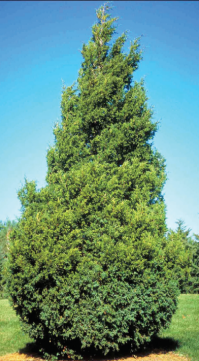
by Sheila Dunning | Dec 5, 2016
 Throughout history the evergreen tree has been a symbol of life. “Not only green when summer’s here, but also when
Throughout history the evergreen tree has been a symbol of life. “Not only green when summer’s here, but also when 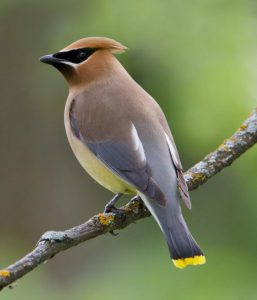 it’s cold and dreary” as the Christmas carol “O Tannenbaum” says. While supporting the cut Christmas tree industry does create jobs and puts money into local economics, every few years consider adding to the urban forest by purchasing a living tree. Native evergreen trees such as Redcedar make a nice Christmas tree that can be planted following the holidays. The dense growth and attractive foliage make Redcedar a favorite for windbreaks, screens and wildlife cover. The heavy berry production provides a favorite food source for migrating Cedar Waxwing birds. Its high
it’s cold and dreary” as the Christmas carol “O Tannenbaum” says. While supporting the cut Christmas tree industry does create jobs and puts money into local economics, every few years consider adding to the urban forest by purchasing a living tree. Native evergreen trees such as Redcedar make a nice Christmas tree that can be planted following the holidays. The dense growth and attractive foliage make Redcedar a favorite for windbreaks, screens and wildlife cover. The heavy berry production provides a favorite food source for migrating Cedar Waxwing birds. Its high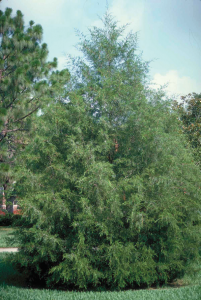 salt-tolerance makes it ideal for coastal locations. Their natural pyramidal-shape creates the traditional Christmas tree form, but can be easily pruned as a street tree. Two species, Juniperus virginiana and Juniperus silicicola are native to Northwest Florida. Many botanists do not separate the two, but as they mature, Juniperus silicicola takes on a softer, more informal look. When planning for using a live Christmas tree there are a few things to consider. The tree needs sunlight, so restrict its inside time to less than a week. Make sure there is a catch basin for water under the tree, but never allow water to remain in the tray and don’t add fertilizer. Locate your tree in the coolest part of the room and away from heating ducts and fireplaces. After Christmas, install the Redcedar in an open, sunny part of the yard. After a few years you will be able to admire the living fence with all the wonderful memories of many years of holiday celebrations. Don’t forget to watch for the Cedar Waxwings.
salt-tolerance makes it ideal for coastal locations. Their natural pyramidal-shape creates the traditional Christmas tree form, but can be easily pruned as a street tree. Two species, Juniperus virginiana and Juniperus silicicola are native to Northwest Florida. Many botanists do not separate the two, but as they mature, Juniperus silicicola takes on a softer, more informal look. When planning for using a live Christmas tree there are a few things to consider. The tree needs sunlight, so restrict its inside time to less than a week. Make sure there is a catch basin for water under the tree, but never allow water to remain in the tray and don’t add fertilizer. Locate your tree in the coolest part of the room and away from heating ducts and fireplaces. After Christmas, install the Redcedar in an open, sunny part of the yard. After a few years you will be able to admire the living fence with all the wonderful memories of many years of holiday celebrations. Don’t forget to watch for the Cedar Waxwings.
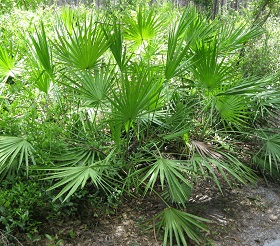
by Sheila Dunning | Jun 3, 2016
According to the Atlas of Florida Vascular Plants, there are more than 4,200 plant species naturally occurring in the state. Nearly 3,000 are considered native. The Florida Native Plant Society (FNPS) defines native plants as “those species occurring within the state boundaries prior to European contact, according to the best available scientific and historical documentation.” In other words, the plants that grew in natural habitats that existed prior to development.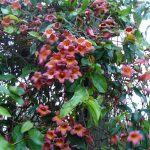
Native plants evolved in their own ecological niches. They are suited to the local climate and can survive without fertilization, irrigation or cold protection. Because a single native plant species usually does not dominate an area, there is biodiversity. Native plants and wildlife evolved together in communities, so they complement each other’s needs. Florida ranks 7th among all 50 states in biodiversity for number of species of vertebrates and plants. Deer browse on native vines like Crossvine (Bignonia capreolata), Trumpet Creeper (Campsis radicans), Yellow Jessamine (Gelsemium sempervirens) and Trumpet Honeysuckle (Lonicera sempervirens). The seeds and berries of Black-eyed Susan (Rudbeckia fulgida), Flowering Dogwood (Cornus florida) and Dahoon holly (Ilex cassine) provide vital food for songbirds, both local and migratory. Saw palmetto (Serenoa repens) provides cover for numerous birds and small mammals, as well as, reptiles.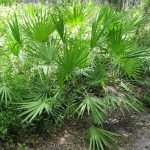
Non-native plants become “naturalized” if they establish self-sustaining populations. Nearly one-third of the plants currently growing wild in Florida are not native. While these plant species from other parts of the world may provide some of the resources needed by native wildlife, it comes at a cost to the habitat. These exotic plants can become “invasive”, meaning they displace native plants and change the diverse population into a monoculture of one species. Chinese privet (Ligustrum sinense), Popcorn trees (Triadica sebifera) and Cogongrass (Imperata cylindrica) have changed the landscape of Florida over the past decade. While Water hyacinth (Eichhornia crassipes) and Hydrilla (Hydrilla verticillata) have changed water flow in many rivers and lakes. These invasive species cost millions of taxpayer dollars to control.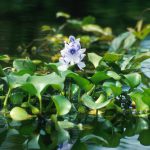
By choosing to use native plants and removing non-native invasive plants, individuals can reduce the disruptions to natural areas. For more information one specific native plants that benefit wildlife go to: http://edis.ifas.ufl.edu/uw384
It learn which plants are invasive go to: http://www.fleppc.org/list/2015FLEPPCLIST-LARGEFORMAT-FINAL.pdf
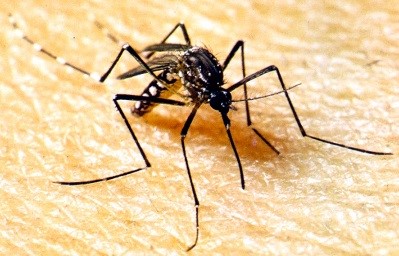
by Sheila Dunning | Mar 12, 2016
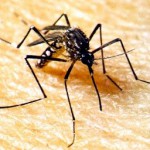 With all the news about the Zika virus spread in Florida, now is the time to start thinking about mosquito protection. As the weather warms, they will be hatching. Check out where the water is collecting in your yard. The female Aedes aegypti mosquitoes lay their eggs in temporary flood water pools; even very small ones such as pet watering bowls, bird baths and upturned Magnolia or Oak leaves. Dumping out the collection containers and raking through the leaves every couple of days can greatly reduce the population.
With all the news about the Zika virus spread in Florida, now is the time to start thinking about mosquito protection. As the weather warms, they will be hatching. Check out where the water is collecting in your yard. The female Aedes aegypti mosquitoes lay their eggs in temporary flood water pools; even very small ones such as pet watering bowls, bird baths and upturned Magnolia or Oak leaves. Dumping out the collection containers and raking through the leaves every couple of days can greatly reduce the population.
Becoming infected with Zika virus is not common. Though the disease can be transmitted by mosquitoes, blood transfusions or sex, the only know infections in Florida were from people who had been “bitten” by mosquitoes while travelling to countries with active virus outbreaks. That is until this past week, when a person-person infection occurred between a man that had been infected while out of the country and the woman he returned to in Florida. Mosquitoes usually obtain the virus by feeding on infected people, who may not exhibit any symptoms because they have been exposed and their body has built an immunity to the virus. Once the mosquito has drawn infected blood from the person, the infected mosquito “bites” another human, transmitting the virus mixed in saliva into the blood stream of the second host. If the second host is a susceptible pregnant woman, there is a risk of birth defects for the unborn child. If the infected host is a man, he can transmit the virus in semen for about two weeks.
Government public health officials here in Florida are able to monitor mosquito-borne illnesses quickly and effectively. Though the daily news can be alarming, the awareness is truly the message.
To protect yourself and reduce the sources for mosquitoes to breed, here are a few pointers:
Stay indoors at dusk (peak mosquito biting time).
If you must be outside, wear long sleeves and pants and/or mosquito repellents containing the active ingredient DEET.
Repair torn door and window screens.
Remove unnecessary outside water sources.
Flush out water collected in outdoor containers every 3-4 days.
Disturb or remove leaf litter, including roof gutters and covers on outdoor equipment.
Apply larvicides, such as Bacillus thuriengensis israelensis (BTI) to temporary water holding areas and containers.
The mosquitoes have been around all winter with the milder weather and frequent rain. As spring approaches they will be laying eggs on all the water surfaces they can find. As you venture out into the yard or travel to the great outdoors, remember to protect yourself and look at all the ways you can remove the potential habitats for the pesky creatures.

by Sheila Dunning | Feb 26, 2016
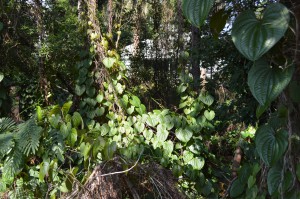
Air potato vine. Photo by Scott Jackson
Air potato (Dioscores bulbifera) is a perennial, herbaceous self-twining vine that can grow over 60 feet in length, enabling it to climb over and smother many native plants. The Florida Exotic Plant Pest Council (FLEPPC) lists air potato as a Category 1 invasive plant, which means that it has disrupted natural communities and ecological functions by displacing native plant species.
In 2012, a leaf feeding beetle (Lilioceris cheni) was introduced into South Florida from China for biological control of air potato. Although it is too early to determine any potential long-term impacts, the initial results have been promising. The larvae and adults of the air potato leaf beetle feed on the leaf tissue and occasionally the bulbils. The damage to the growing tips of the plant have dramatically reduced its ability to cover native vegetation. Extensive damage to air potato was evident within three months after the first release. Additionally, testing by scientists at the USDA/ARS Invasive Plant Research Laboratory in Fort Lauderdale concluded that the beetle will not complete development on any other plant found in Florida.
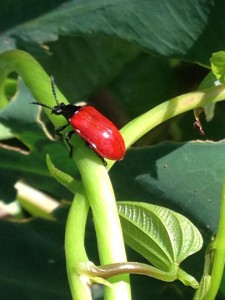
Air potato beetle up close. Photo by Julie McConnell
The female air potato leaf beetle lays an average of 1,200 eggs, which develop into larvae in about four days. The young beetles skeletonize the air potato leaves for the next eight days and then pupate into foam-like cocoons. Clumps of cocoons fall to the ground and the adult beetles emerge 13 to 16 days later. There can be a new generation of air potato leaf beetle every month while the weather is warm. For the winter, the adults hide in leaf litter and wait for spring.
The question now is: “How well will they survive through a longer, colder Northwest Florida winter?”. USDA scientists, UF Extension agents and citizen scientists in Bay and Okaloosa County hope to find out. Earlier this month, June 2015, air potato leaf beetles from the Hayslip Biological Control and Research and Containment Laboratory in Ft. Pierce were released into areas containing air potato. They will be monitored over the next year. Look for an update this coming summer.
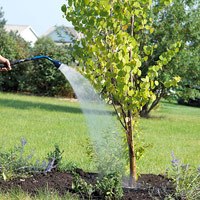
by Sheila Dunning | Jan 23, 2016
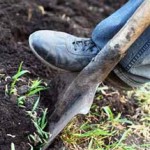 The best time to plant a tree is twenty years ago. The second best time is for Arbor Day. Florida recognizes the event on the third Friday in January, but planting any time before spring will establish a tree quickly.
The best time to plant a tree is twenty years ago. The second best time is for Arbor Day. Florida recognizes the event on the third Friday in January, but planting any time before spring will establish a tree quickly.
Arbor Day is an annual observance that celebrates the role of trees in our lives and promotes tree planting and care. As a formal holiday, it was first observed on April 10, 1872 in the state of Nebraska. Today, every state and many countries join in the recognition of trees impact on people and the environment.
Trees are the longest living organisms on the planet and one of the earth’s greatest natural resources. They keep our air supply clean, reduce noise pollution, improve water quality, help prevent erosion, provide food and building materials, create shade, and help make our landscapes look beautiful. A single tree produces approximately 260 pounds of oxygen per year. That means two mature trees can 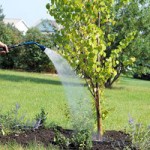 supply enough oxygen annually to support a family of four.
supply enough oxygen annually to support a family of four.
The idea for Arbor Day in the U.S. began with Julius Sterling Morton. In 1854 he moved from Detroit to the area that is now the state of Nebraska. J. Sterling Morton was a journalist and nature lover who noticed that there were virtually no trees in Nebraska. He wrote and spoke about environmental stewardship and encouraged everyone to plant trees. Morton emphasized that trees were needed to act as windbreaks, to stabilize the soil, to provide shade, as well as, fuel and building materials for the early pioneers to prosper in the developing state.
In 1872, The State Board of Agriculture accepted a resolution by J. Sterling Morton “to set aside one day to plant trees, both forest and fruit.” On April 10, 1872 one million trees were planted in Nebraska in honor of the first Arbor Day. Shortly after the 1872 observance, several other states passed legislation to observe Arbor Day. By 1920, 45 states and territories celebrated Arbor Day. Richard Nixon proclaimed the last Friday in April as National Arbor Day during his presidency in 1970.
Today, all 50 states in the U.S. have official Arbor Day, usually at a time of year that has the correct climatological conditions for planting trees. For Florida, the ideal tree planting time is January, so Florida’s Arbor Day is celebrated on the third Friday of the month. Similar events are observed throughout the world. In Israel it is the Tu B Shevat (New Year for Trees). Germany has Tag des Baumes . Japan and Korea celebrate an entire week in April. Even, Iceland one of the treeless countries in the world observes Student’s Afforestation Day.
The trees planted on Arbor Day show a concern for future generations. The simple act of planting a tree represents a belief that the tree will grow and some day provide wood products, wildlife habitat erosion control, shelter from wind and sun, beauty, and inspiration for ourselves and our children.
“It is well that you should celebrate your Arbor Day thoughtfully, for within your lifetime the nation’s need of trees will become serious. We of an older generation can get along with what we have, though with growing hardship; but in your full manhood and womanhood you will want what nature once so bountifully supplied and man so thoughtlessly destroyed; and because of that want you will reproach us, not for what we have used, but for what we have wasted.”
~Theodore Roosevelt, 1907 Arbor Day Message

 Throughout history the evergreen tree has been a symbol of life. “Not only green when summer’s here, but also when
Throughout history the evergreen tree has been a symbol of life. “Not only green when summer’s here, but also when  it’s cold and dreary” as the Christmas carol “O Tannenbaum” says. While supporting the cut Christmas tree industry does create jobs and puts money into local economics, every few years consider adding to the urban forest by purchasing a living tree. Native evergreen trees such as Redcedar make a nice Christmas tree that can be planted following the holidays. The dense growth and attractive foliage make Redcedar a favorite for windbreaks, screens and wildlife cover. The heavy berry production provides a favorite food source for migrating Cedar Waxwing birds. Its high
it’s cold and dreary” as the Christmas carol “O Tannenbaum” says. While supporting the cut Christmas tree industry does create jobs and puts money into local economics, every few years consider adding to the urban forest by purchasing a living tree. Native evergreen trees such as Redcedar make a nice Christmas tree that can be planted following the holidays. The dense growth and attractive foliage make Redcedar a favorite for windbreaks, screens and wildlife cover. The heavy berry production provides a favorite food source for migrating Cedar Waxwing birds. Its high salt-tolerance makes it ideal for coastal locations. Their natural pyramidal-shape creates the traditional Christmas tree form, but can be easily pruned as a street tree. Two species, Juniperus virginiana and Juniperus silicicola are native to Northwest Florida. Many botanists do not separate the two, but as they mature, Juniperus silicicola takes on a softer, more informal look. When planning for using a live Christmas tree there are a few things to consider. The tree needs sunlight, so restrict its inside time to less than a week. Make sure there is a catch basin for water under the tree, but never allow water to remain in the tray and don’t add fertilizer. Locate your tree in the coolest part of the room and away from heating ducts and fireplaces. After Christmas, install the Redcedar in an open, sunny part of the yard. After a few years you will be able to admire the living fence with all the wonderful memories of many years of holiday celebrations. Don’t forget to watch for the Cedar Waxwings.
salt-tolerance makes it ideal for coastal locations. Their natural pyramidal-shape creates the traditional Christmas tree form, but can be easily pruned as a street tree. Two species, Juniperus virginiana and Juniperus silicicola are native to Northwest Florida. Many botanists do not separate the two, but as they mature, Juniperus silicicola takes on a softer, more informal look. When planning for using a live Christmas tree there are a few things to consider. The tree needs sunlight, so restrict its inside time to less than a week. Make sure there is a catch basin for water under the tree, but never allow water to remain in the tray and don’t add fertilizer. Locate your tree in the coolest part of the room and away from heating ducts and fireplaces. After Christmas, install the Redcedar in an open, sunny part of the yard. After a few years you will be able to admire the living fence with all the wonderful memories of many years of holiday celebrations. Don’t forget to watch for the Cedar Waxwings.











